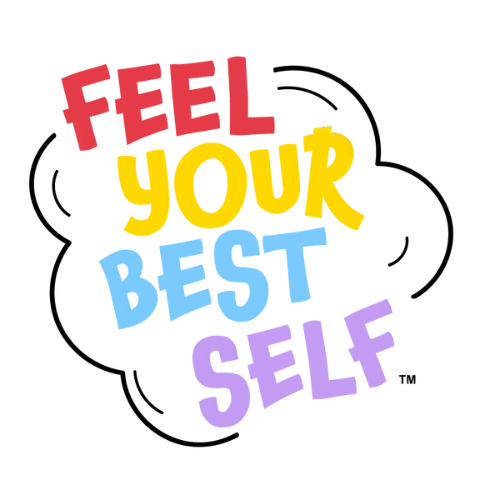
FAQs
-
Absolutely! We just ask that you credit FYBS, and we’d love to hear how it goes. For specific details about using FYBS materials, please read our Terms of Use.
-
Twelve core strategies are featured in FYBS. Our team worked to map the evidence in emotion regulation, selecting those strategies that could be taught quickly for anyone to use in shifting their feelings in the moment. We organized the 12 strategies into three categories that could resonate with kids: Calm Your Self, Catch Your Feelings and Connect with Others. Calm Yourself strategies focus on self-soothing skills that settle the body or refocus attention. Often these strategies incorporate physical movement, like Belly Breathing or Shaking out the Yuck. Catch your Feelings strategies support self-awareness of one's emotional state, again helping us re-focus attention or shift our thoughts, like Turn the Dial or Push the Clouds. Finally, Connecting with Others strategies are all about social relationships, which could be choosing, offering, or seeking connection. Bring a High 5! or Be a Kind Helper can help both others and ourselves to feel our best.
-
COVID thrust a huge spotlight on increasing mental health concerns. The stress over the past few years has amplified these concerns as kids and their caregivers find their coping skills to be not typically developed or stretched too thin. Our team was concerned about the capacity for schools to meet this need; educators were experiencing the same stressors as the rest of us, so it was unreasonable to expect school systems to be ready to address the social, emotional, and behavioral needs as schools re-opened. This is where we dug deep into what we knew about simple strategies.pdf – the smallest intervention element, rooted in what we know works in psychology – that could be packaged in a fun way to support emotion-focused coping. There are many more details in between, but this is how Feel Your Best Self was born. Our goal was to give every person options to help them navigate their feelings in the moment using fun, simple strategies.
-
We know that finding time during the school day can be a challenge. FYBS materials were designed for efficient use – each video is under 5 minutes!
We encourage you to think about FYBS as fitting within your existing day, not as a new initiative to add onto an already full plate. For example, FYBS discussion could be part of your morning meeting time, videos can be scheduled as part of transition time, and puppet-making can be a fun indoor recess activity.
Our Facilitator Guide Overview.pdf offers additional suggestions for putting FYBS into your existing classroom routines and activities to support emotional well-being. In addition, we encourage collaboration with school leaders to carve dedicated time in the schedule.
-
Remember that FYBS was designed to be flexible. It’s not a structured program or curriculum: it can be adapted to fit into existing routines. That said, it is important to make sure that you have the necessary support to make it work for you. Discuss with your colleagues when, how, and where FBYS might fit in your school day. We recommend sharing the FYBS.pdf Overview handout with school leaders and families to learn about FYBS and its benefits. And remember to emphasize that the toolkit is available at no cost to you or your setting!
-
FYBS is fun and free! This means that materials can be accessed by everyone – as many times and in whatever way works for them. When learning something new, we all need repeated opportunities to see it, practice it, and get feedback about it. Thus, sharing how classrooms are using FYBS and how to find ways to practice at home can be a great way to strengthen learning the FYBS strategies. It is easy to share the link to the video episodes, which also contains tip sheets to talk about the strategies in any setting!
Families can also be involved in puppet-making to share their creativity and extra helping hands! Consider inviting family volunteers to join in your puppet-making activity or related activities such as watching puppet skits (live or recorded).
-
The facilitator guide offers suggestions for adapting materials but remember that you are the expert regarding the kids you work with! Use your expertise to modify FYBS to best meet the needs of your kids.
For young children, this might mean breaking a strategy into very small chunks, providing shorter and more blocks for learning, and additional opportunities for repeated practice. If using the puppet-making activity, you might advance prepare more parts to the sock puppet.
For older children, you might encourage more independent use of different materials in their puppet creations. You might also integrate the strategy concepts into academic learning, such as reflecting as to how a character in the chapter book they are reading used or could use a particular FYBS strategy.
-
Adding puppet-making into FYBS provides a hands-on, interactive activity. Using their own creation, kids have a safe friend with whom they can teach and practice the FYBS strategies. Practicing FYBS strategies with their puppet friends reinforces what kids have learned while allowing them to explore their creativity. Kids can work together to create fun FYBS skits with their puppet friends.
-
The great thing about the puppet-making component of Feel Your Best Self is that you do not have to be an artist to make an adorable, useful, and creative puppet! In fact, modeling puppet-making as a non-artist can be a great way to show children that
- it is okay if their puppet isn’t perfect
- puppetry = creativity – there is no “right” or “wrong” when it comes to making a puppet
- and making a puppet is about having fun!
- you don’t have to have special supplies; you can make almost anything into a puppet with a little creativity!



